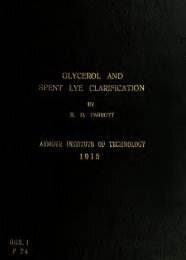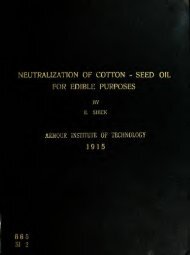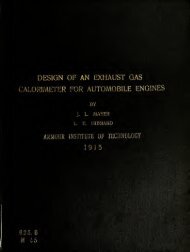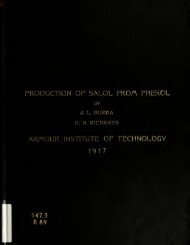View/Open - Illinois Institute of Technology
View/Open - Illinois Institute of Technology
View/Open - Illinois Institute of Technology
You also want an ePaper? Increase the reach of your titles
YUMPU automatically turns print PDFs into web optimized ePapers that Google loves.
ELECTRIC SERVICE U P P L I E S COMPANY<br />
Arrester such a high recnrd f(ir efficienc}' and service. In this type<br />
EG Arrester, the air gap distance l)et\veen line and ground is 1/40<br />
(.025) inch.<br />
To limit the flow <strong>of</strong> normal current that can follow the discharge<br />
to ground, we employ the upper section <strong>of</strong> the resistance rod, there<br />
being approximately 60 ohms between discharge point C and clanip<br />
D. This keeps the current down to a value that is<br />
broken readily by the circuit breaker, and is not<br />
enough resistance to impede the passage <strong>of</strong> the<br />
discharge.<br />
Important constructional details <strong>of</strong> Garton-<br />
Daniels Direct Current Lightning Arresters are<br />
ample surface distances on the base between parts<br />
<strong>of</strong> diiiferent potentials ; if these ample distances<br />
were not allowed, A\dTen the base became dusty<br />
and wet from condensation, the line voltage would<br />
frequently arc over between metal parts and result<br />
in the destruction <strong>of</strong> the Arrester. Resistance<br />
rods are <strong>of</strong> low resistance and <strong>of</strong> great efficiency<br />
in conducting high frequency static and light-<br />
ning. This resistance is permanent—that is, is<br />
unaiifected by the passage <strong>of</strong> static discharges as<br />
some rods are. This means that the efficiency <strong>of</strong><br />
the Arrester is not decreased after continued service due to an increase<br />
in rod resistance.<br />
The resistance rod is supported by the Brackets D and E, the<br />
upper end <strong>of</strong> the rod being free from contact with the base. In this<br />
way a distance <strong>of</strong> 2^ inches on the surface <strong>of</strong> the base is secured<br />
between the support for the upper discharge point B and the bracket<br />
D. This feature is new in lightning arrester design, and entirely<br />
removes one <strong>of</strong> the weak points found in former types. The lower<br />
discharge point C is cemented tn the md by means <strong>of</strong> a special<br />
metallic cement that has been thnmughly tried out and found<br />
permanent.<br />
The design <strong>of</strong> Garton-Danicls Lightning Arresters throughout<br />
assures Arresters <strong>of</strong> very high cflicicncy. Furthermore, service tests<br />
demonstrate that a long life is assured, and the best <strong>of</strong> results<br />
throughout a period <strong>of</strong> years may be expected.<br />
47













